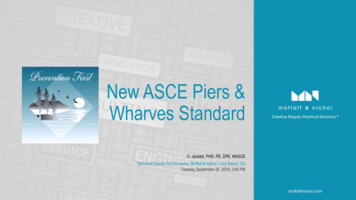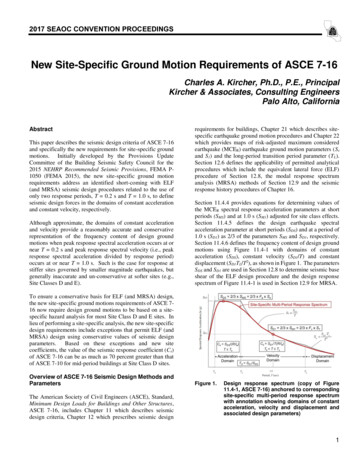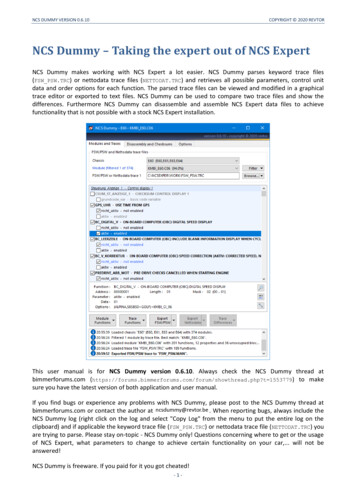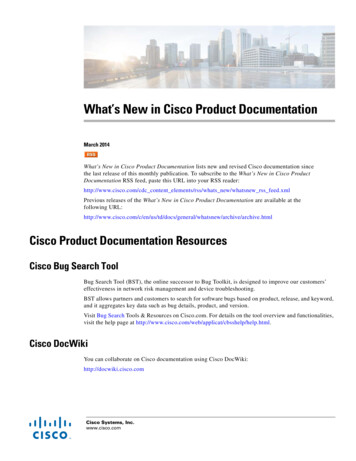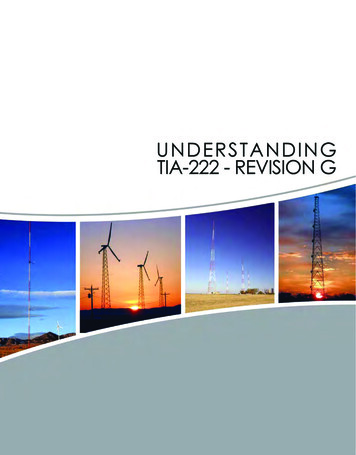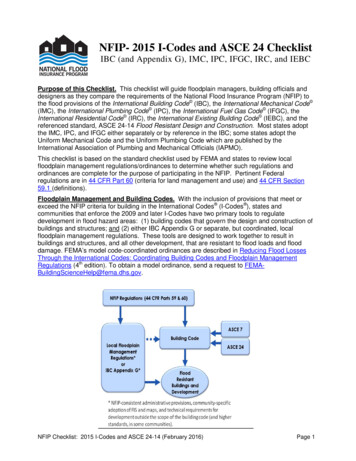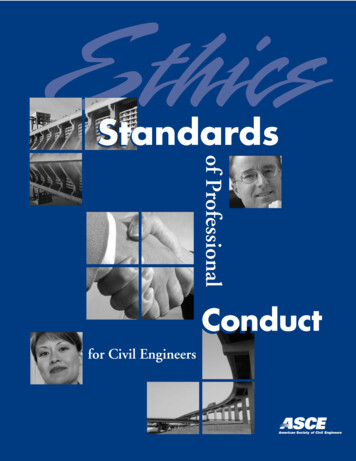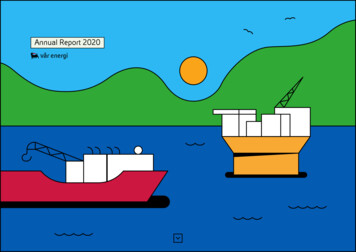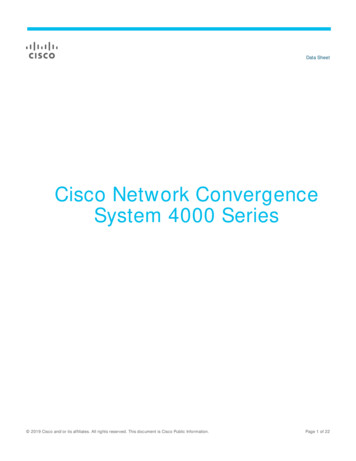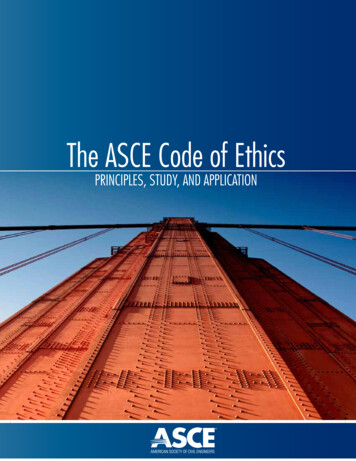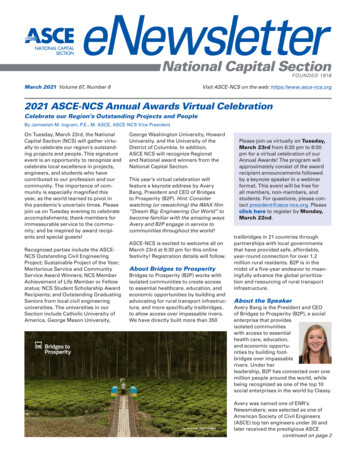
Transcription
March 2021 Volume 67, Number 6Visit ASCE-NCS on the web: https://www.asce-ncs.org2021 ASCE-NCS Annual Awards Virtual CelebrationCelebrate our Region’s Outstanding Projects and PeopleBy Jameelah M. Ingram, P.E., M. ASCE, ASCE-NCS Vice PresidentOn Tuesday, March 23rd, the NationalCapital Section (NCS) will gather virtually to celebrate our region’s outstanding projects and people. This signatureevent is an opportunity to recognize andcelebrate local excellence in projects,engineers, and students who havecontributed to our profession and ourcommunity. The importance of community is especially magnified thisyear, as the world learned to pivot inthe pandemic’s uncertain times. Pleasejoin us on Tuesday evening to celebrateaccomplishments; thank members forimmeasurable service to the community; and be inspired by award recipients and special guests!Recognized parties include the ASCENCS Outstanding Civil EngineeringProject; Sustainable Project of the Year;Meritorious Service and CommunityService Award Winners; NCS MemberAchievement of Life Member or Fellowstatus; NCS Student Scholarship AwardRecipients; and Outstanding GraduatingSeniors from local civil engineeringuniversities. The universities in ourSection include Catholic University ofAmerica, George Mason University,George Washington University, HowardUniversity, and the University of theDistrict of Columbia. In addition,ASCE NCS will recognize Regionaland National award winners from theNational Capital Section.This year’s virtual celebration willfeature a keynote address by AveryBang, President and CEO of Bridgesto Prosperity (B2P). Hint: Considerwatching (or rewatching) the IMAX film“Dream Big: Engineering Our World” tobecome familiar with the amazing waysAvery and B2P engage in service tocommunities throughout the world!ASCE-NCS is excited to welcome all onMarch 23rd at 6:30 pm for this onlinefestivity! Registration details will follow.About Bridges to ProsperityBridges to Prosperity (B2P) works withisolated communities to create accessto essential healthcare, education, andeconomic opportunities by building andadvocating for rural transport infrastructure, and more specifically trailbridges,to allow access over impassable rivers.We have directly built more than 350Please join us virtually on Tuesday,March 23rd from 6:30 pm to 8:00pm for a virtual celebration of ourAnnual Awards! The program willapproximately consist of the awardrecipient announcements followedby a keynote speaker in a webinarformat. This event will be free forall members, non-members, andstudents. For questions, please contact president@asce-ncs.org. Pleaseclick here to register by Monday,March 22nd.trailbridges in 21 countries throughpartnerships with local governmentsthat have provided safe, affordable,year-round connection for over 1.2million rural residents. B2P is in themidst of a five-year endeavor to meaningfully advance the global prioritization and resourcing of rural transportinfrastructure.About the SpeakerAvery Bang is the President and CEOof Bridges to Prosperity (B2P), a socialenterprise that providesisolated communitieswith access to essentialhealth care, education,and economic opportunities by building footbridges over impassablerivers. Under herleadership, B2P has connected over onemillion people around the world, whilebeing recognized as one of the top 10social enterprises in the world by Classy.Avery was named one of ENR’sNewsmakers; was selected as one ofAmerican Society of Civil Engineers(ASCE) top ten engineers under 30 andlater received the prestigious ASCEcontinued on page 2
President’s CornerIn the month of March theNCS will be continuingour tradition of celebrating our Students and otherawards recipients at ourAnnual Awards Banquet.The Awards Banquet willlook a bit different this yearand will be held in a virtualformat due to the ongoingpandemic, but nonethelesswe’ll still be taking the opportunityto highlight members and projectsthroughout our section. We havefive local university student chapterslocated within the NCS, and we’llbe presenting Outstanding StudentAwards and various scholarships tostudents from each of our universitychapters. In addition tothe student awards, we’llbe highlighting Projectof the Year, SustainableProject of the Year, as wellas recognizing some ofour volunteer members. Iwould encourage the NCSmembership to attend thisyear’s Awards Banquet tohelp honor our awards andscholarship recipients.Moving forward into the spring andearly summer, a bulk of the NCSevents will likely remain virtual basedon guidance ASCE has provided atthe Society level. Notwithstandingthe NCS will continue to hold VirtualSection Meetings (lunchtime presentations) through May; please keep an eyeout to email announcements for theApril and May Section Meetings, aswell as various committee activities.Please feel free to reach-out at president@asce-ncs.org about ASCE NCSrelated activities, or if you have an ideafor a potential future event or activities. I hope everyone is safe duringthese trying times, and I can’t waituntil we can once again all meet inperson!Mike Venezia, PEASCE-NCS President2021 ASCE-NCS Annual Awards Virtual Celebrationcontinued from page 1President’s Medal. She was featuredin the IMAX film D ream Big and hasspoken on stages ranging from TEDto the UN. She has been recognizedwith the coveted Mulago FoundationRainer Arnhold Fellowship and the GLG(Gerson Lehrman Group) Social ImpactFellowship and is a member of theYoung Presidents’ Organization (YPO),Aspen chapter.Avery is a Distinguished Alumni ofThe University of Iowa, where shecompleted degrees in Studio Art andCivil Engineering, and The Universityof Colorado at Boulder where shecompleted a MSc in GeotechnicalEngineering. She earned an MBA fromThe University of Oxford, where shewas nominated by her peers as a graduation speaker, and she received an honorary doctorate degree from ClarksonUniversity. nUpcoming EventsUntil further notice, all in-person ASCE NCS events have been cancelled. Opportunities for virtual events will beannounced as they are planned.NewsletterMaria Raggousis, EditorApril 2021 Issue Deadline: March 22, 2021To Submit Articles: newsletter@asce-ncs.orgNCS eNewsletter Archives: go to www.asce-ncs.org and view alongthe sidebar.Address Changes: Call 1-800-548-ASCE, e-mail member@asce.org,visit www.asce.org, or write: ASCE – Membership, 1801 Alexander BellDrive, Reston, VA 20191. Include your membership number.2 ASCE-NCS eNewsletter: March 2021 National Capital SectionOfficers (2020–2021)Mike Venezia, PresidentJameelah Ingram, Vice PresidentVic Crawford, TreasurerNorine Walker, SecretaryKelly Cronin, Past PresidentEmily Dean, Previous PastPresidentMaria Raggousis, NewsletterEditorAriana White, YMF PresidentLisa Anderson, DirectorElizabeth Wheeler, DirectorTricia Wolfbauer, DirectorJoseph Whartenby Jr., DirectorShainur Ahsan, Reston BranchPresidentCommittee ChairsPlease refer to the NCS website fora current list of NCS committeesand chairs.https://www.asce-ncs.org
Virginia Centennial Celebration –ASCE Serving the Commonwealth Since 1922In 1922, a group of Virginia CivilEngineers obtained approval fromASCE to establish the Virginia Section.The Objective, the “Advancement ofengineering knowledge and practice,the cultivation of friendly relations withall engineers, the maintenance of highprofessional standards, and cooperation with other societies, with aview of promoting the generalwelfare of the engineeringprofession and the AmericanSociety of Civil Engineers.”Therefore, in 2022, the VirginiaSection will be celebrating onehundred years of serving thecivil engineering needs of theprofession and the public in thepursuit of this Objective. Sincethe Section originally includedall of the Commonwealth, to honor thishistoric support for all Virginia civil engineers, a decision was made to includeall Virginia civil engineering accomplishments in the Celebration. Therefore, theVirginia counties in the National CapitalSection’s (NCS) membership area areinvited to be a part of this CentennialCelebration.civil engineers in the public, private,and education sectors. Since the Galacelebrates all civil engineers in Virginia,NCS members in Virginia are alsoinvited to attend this once-in-a-hundredyear event. So, mark your calendar forMarch 26, 2022. You do not want to missthis opportunity to honor our professionwhile we celebrate and socialize with other civil engineersand supporters from acrossthe Commonwealth of Virginia.The Virginia Centennial logoused the Fink Deck TrussBridge, an ASCE NHCEL, inLynchburg, Virginia as anexcellent example of historic civil engineering and atrue representation for theCentennial Celebration. Below are photographs of the Fink Deck Truss Bridgein Lynchburg’s Riverside Park.As an early Centennial action, theVirginia Section installed a new plaquein coordination with Nelson CountyParks and Recreation at the CrozetTunnel (another NHCEL). This plaquewas unveiled in September 2020, butdue to COVID-19, attendance waslimited to Virginia State Officials only.Therefore, the Virginia Section will beholding a dedication ceremony this yearwhen ASCE members from across thestate can attend. As shown in the photographs below, the plaque is mounted ona pedestal with stonework reminiscentof that used for the tunnel.One of the first actions of the CentennialCommittee was to develop the logoshown above. The Committee alsohas actions under way to develop aCentennial Pamphlet that can be usedas a handout when members arepresenting the benefits of pursuingScience, Technology, Engineering, andMath (STEM) to schools and careerfairs across the state, including thosein the NCS. Also, under development,an interactive map showing ASCENational Historic Civil EngineeringLandmarks (NHCEL) and other significant civil engineering projects acrossthe Commonwealth for use by teachersand parents to show future engineersour accomplishments and what we doas civil engineers.The key event in the Virginia Section’sCelebration will be a Centennial Gala.The Section plans to host the Gala atthe Omni Richmond on Saturday, March26, 2022. They have already reachedout to the 2022 ASCE President to beour keynote speaker. Plans are stillbeing developed, but they will includea Celebration dinner; keynote speaker;and awards given to ASCE Members,supporting companies, and outstanding3 ASCE-NCS eNewsletter: March 2021 Borrowing from the NCS’s Centennial in2016, Virginia is planning a CentennialCelebration boat tour of the bridgesand other civil engineering projectsin the Virginia Tidewater area, providing an opportunity for ASCE membersto bring their next generation of civilengineers and family to learn how ourprofession has served the public for thecontinued on page 4https://www.asce-ncs.org
Virginia Centennial Celebration – ASCE Serving the Commonwealth Since 1922continued from page 3last hundred years. The Virginia Sectionwill also be hosting tours at other ASCElandmarks across the state using theinteractive map that will have historicalphotos and write ups of the projects.In addition, historical information andphotos collected for the Centennialwill be posted on the Virginia Section’swebsite, similar to what is still postedon the NCS’s Centennial webpage. AllCivil Engineers in Virginia should belooking forward to this Celebration, andthis once-in-a-hundred-year opportunity to not only recognize those civilengineers that have gone before usbut to also inspire the next generationof civil engineers through the STEMCentennial Pamphlet, interactive map,and Centennial tours. nDr. Z’s CornerTEQUALIZER: Reinventing HVAC VentsUsing Artificial Intelligence (AI)On a nice Sunday back in 2019, threefriends, all engineers and scholars,were enjoying brunch together ina local restaurant, and one of themstarted complaining about temperature differences across rooms in theirhouses and workplaces. Instantly, all ofthem agreed on the problem, startedsharing their individual experiencesand stories with each other. In the end,they decided to team up to reinventnew HVAC vents through transdisciplinary research.ProblemHVAC (Heating, Ventilating, and AirConditioning) systems are engineeredto be integrated into our infrastructure to provide us with a comfortableindoor environment. An HVAC thermostat allows us to choose a desired levelof temperature in the associated HVACzone. In real applications though, weoften stay in an HVAC zone with varying temperature across rooms. This isbecause of several reasons including,but not limited to, the specific activityoccurring in each room, the naturalenvironment of each room (e.g., thedirections and sizes of windows), theequipment operating in each room,and the distance of each room’s ventsfrom the HVAC. Therefore, even ifthe temperature at the location ofthe thermostat is maintained withina comfortable temperature range asset, individual rooms can have largedeviations in air temperature, creatingan uncomfortable indoor environmentor incurring wasted energy in heatingand cooling.Suppose that there are two rooms(A and B) in an HVAC zone withthe thermostat located in Room A.4 ASCE-NCS eNewsletter: March 2021 ProblemFurther suppose that, while the HVACis running, Room A reaches the settemperature sooner than Room B.Because the thermostat is in Room A,the HVAC stops running – Room B isstill uncomfortable. On the other hand,if the thermostat is installed in RoomB instead, the HVAC would continueto run based on the air temperature ofRoom B, overheating or overcoolingRoom A. Micro HVAC zoning is mostlyprohibitive due to cost, complexity,and a variety of other reasons (e.g.,rental properties or businesses in commercial buildings).ApproachSuch limitations of conventional HVACsystems led some businesses to theinvention of smart vents in recentyears. However, existing smart ventsare complex to set up and use, notadequate for commercial buildings,and require additional devices, such assmart thermostats, additional sensorcontinued on page 5Approachhttps://www.asce-ncs.org
Dr. Z’s Corner,continuedmodules, and smart hubs. Therefore,they are not scalable and not applicable to a wide spectrum of customers.By combining modern technological advancements made in computerscience and information technology, we can design more intelligentHVAC vents that can do more for theconvenience of human users, ideallyproviding a “simply drop-in & forget” solution that requires no additional devices or complicated humaninvolvements. In particular, recentadvancements in Artificial Intelligence(AI), Internet of Things (IoT), and tinyembedded computers, combined withthe increasingly faster data communications and cloud computing, enableus to devise a new human-centeredapproach in reinventing HVAC vents.Such HVAC vents should be able toimprove the quality of our indoor livingenvironment while saving energy, allin a human-friendly and cost-efficientway.PrototypeHere, the key idea is to embed an AI(Artificial Intelligence) and sensors intoeach vent to enable them to autonomously collaborate, sense, and sharetheir local environment with eachother. Tequalizer vents actually registerand collaborate in real time with eachother to collectively control all dampers in such a way that the heating/cooling is dynamically redirectedamong the vents to reach and maintainuniform temperatures across rooms. Aprovisional application for patent hasbeen submitted.Co-authored by Byunggu Yu, AhmetZeytinci, and Junwhan KimPrototypeThrough our interdisciplinary research,we have developed a new type ofHVAC vents that we call Tequalizer (ashort for Temperature Equalizer). Wedesigned Tequalizer to be an energyefficient and human-centered solutionfor making the temperature set ona central HVAC thermostat to be theactual temperature everywhere insidethe HVAC zone.ASCE-NCS Newsletter Patronswww.mkceng.com5 ASCE-NCS eNewsletter: March 2021 continued on page 5https://www.asce-ncs.org
The Abridged Calumet “K”: Episode 5The fascinating novel Calumet “K” by Samuel Merwin and Henry Websterwas published in 1901. Its hero? An efficacious engineer.An 8-episode condensed edition with text by Ranjit Sahai 2021. All Rights Reserved. [Illustrations by Harry Edwards, from novel.]Since his first day on the job the attitudeof the men had worried Bannon a little.There was something in the air hedid not like. Peterson, accustomed tohandling smaller bodies of men, hadmade the natural mistake of drivingthe very large force employed on theelevator with much too loose a rein. Themen were still further demoralized bythe episode with the walking delegate,Grady, on Thursday night. Bannon knewtoo much to attempt halfway measures,so he waited for a case of insubordination serious enough to call for severetreatment.In the office about the middle ofSaturday morning, Miss Vogel handedBannon two letters. The one fromBrown stated that Page & Co. werefighting to break the corner in Decemberwheat. To do so, they needed to store22,000 bushels of wheat in Calumet Kbefore January 1, no matter what thecost. The other from Sloan advisedBannon that the remainder of the cribbing would be in Chicago within a week.Bannon got up, buttoned his coat andsaid to Miss Vogel, “Well, I’ve got to goout on the job.”An elevator is a giant warehouse ofbins to store grain. The cupola, whichBannon was about to frame, is a fivestory building perched atop the bins tohouse machinery to weigh and distribute the grain. When Bannon climbed outon top of the bins, he found carpenterspreparing the flooring for the cupolaframework. Below the bins, like beesin a honeycomb, laborers were takingquick as we can make out a time-check. Iwant you to be careful.”He was picking his way over to thegroup of men about the hoisting pole,when a fellow named Reilly, who, tryingto suppress a smile, was peering withmock concern down into the dark bin.“My hammer slipped,” Bannon heardhim say in a loud aside to the man nearest him. Then, with a laugh: “Accidentswill happen.”“I’ve talked to you,” he said, “and I’veknocked you down. But ”down scaffolding that had been used tobuild the bins. At the south of the building, a group of laborers was rigging aboom hoist to lift timbers for framingthe cupola.While Bannon stood watching, one ofthe carpenters sawed off the end of aplank and dropped it down into the bin.There was a low laugh, and one or twoof the men glanced uneasily at Bannon.He spoke to the offender. “Don’t do thatagain if you want to stay on this job.”Then: “Look here,” he called, getting theattention of all the carpenters, “everyman that drops anything into the binsgets docked an hour’s pay. If he doesthat twice, he leaves the job just as“I guess we won’t take the trouble todock you,” Bannon said. “Go to theoffice and get your time.” “Not me. Myhammer just slipped. How’re you goingto prove I meant to do it?” “I’m not. Youain’t laid off, you understand; you’refired.” “You don’t dare fire me,” the mansaid, coming nearer. “You can’t comeit on the union that way.” Then, without any preparatory gesture whatever,Bannon knocked him down. The manseemed to fairly rebound from the floor.He rushed at the boss, but before hecould come within striking distance,Bannon whipped out a revolver anddropped it level with Reilly’s face.“I’ve talked to you,” he said slowly, hiseye blazing along the barrel, “and I’veknocked you down. But ” The manstaggered back, then walked away verypale, but muttering. Bannon shovedback the revolver into his hip pocket.“It’s all right, boys,” he said, “nothing toget excited about.”Bannon called Pete and Max to officeand showed them the letter from thecontinued on page 7ASCE-NCS Newsletter Patrons6 ASCE-NCS eNewsletter: March 2021 https://www.asce-ncs.org
The Abridged Calumet “K”: Episode 5continued from page 6office. At the current pace of work heestimated 120 days to complete the job.“That takes us to March 1,” said Max.“You haven’t divided by three yet,” saidBannon. “We’ll get three eight-hourdays in 24-hours, and 21 of ’em intoevery week.” “Why, that gets us twoweeks ahead of time,” said Pete. “I’mfiguring on it as our hard luck margin.We’ll have a strike here and Page & Co.are likely to spring something on usbefore we get through,” said Bannon.Five minutes after the noon whistleblew, on Saturday, every carpenter andlaborer knew that Bannon had “pulled agun” on Reilly. And every man, during the afternoon, kept his eyes moreclosely on his work. Some were angry,but these dropped from muttering intosullenness; the majority were relieved,for a good workman is surer of himselfunder a firm than under a slack hand;but all were cowed. And Bannon knewtoo, that the incident might in the longrun make trouble. But trouble was likelyin any case, and it was better to meet itafter he had established his authoritythan while discipline was at loose ends.One morning, after dictating lettersto Hilda, Bannon asked, “You haven’tbeen on the job yet, have you?” “No, Ihaven’t.” ”Now that we’re framing thecupola, the view ain’t bad,” he wenton, “when you get up there. You cansee down into Indiana, and all the wayaround.” “Why Mr. Bannon,” she said;I’d like to go very much.”As Bannon reached the elevator andbegan to climb the ladder, halfway up hemet Max, who was coming down, timebook in hand. “I’ve asked your sisterto come up and see the framing,” saidBannon. Max glanced down at the looseboards on the landing. “I don’t know,”he said, “I don’t believe she could climbup here very well.” “She won’t have to.You’re going to build a passenger elevator between now and thee o’clock that’sbig and strong enough to carry her.”Max grinned. “Say, that’s alright. She’lllike that. I can build most of it at noon.Bannon inspected the “elevator” andthe tackle that would carry it up, soonafter the afternoon work started. “Youbetter go for your sister,” said Bannon.“Well, Miss Vogel, how do you like it?”asked Bannon after they reached thetop. She was looking eagerly about;at the frame, a great skeleton of newtimber, some of it still holding so muchof the water of river and millyard that itglistened in the sunlight; at the movinggroups of men; at the straining hoist,trembling with each new load that cameswinging from somewhere below,to be hustled off to its place, stick bystick; and then out into the west, wherethe November sun was dropping, andaround at the hazy flats and the strip ofa river. She drew in her breath quicklyand looked up at Bannon with a nervouslittle gesture. “I like it,” she said.ASCE-NCS Newsletter PatronThe next day a lot of cribbing came fromLedyard, and Bannon at once set aboutreorganizing his forces so that workcould go on night and day.It took a few days to get the new systemrunning smoothly – new carpenters andlaborers had to be taken on, and newforemen worked into their duties – but itproved to be less difficult than Max andHilda had supposed from what Petersonhad to say about the conduct of thework. The men all worked better thanbefore; each new move of Bannon’sseemed to infuse more rigor and energyinto the work; and the cupola and annexbegan rapidly, as Max said, ‘to look likesomething.” Bannon was on hand allday, and frequently during a large partof the night. He had a way of appearingat any hour to look at the work and keepit moving. Max, after hearing the daymen repeat what the night men had totell of the boss and his work, said to hissister: “Honest, Hilda, I don’t see how hedoes it. I don’t believe he ever takes hisclothes off.”Novel’s condensed text byRanjit Sahai, ASCE-NCS Past President(2013–14), is a principalwith RAM Corp servingState DOTs on projectsin traffic engineeringdesign, stormwater facility inspections, and information technology. nEmployment ClearinghouseThe NCS provides the Employment Clearinghouse as afree service to its membership. The Clearinghouse allowsmembers to post short notices for available positions orcandidates seeking employment. All employers listedherein are equal opportunity employers. If you have questions, are seeking employment or would like to posta position please contact the newsletter editor.7 ASCE-NCS eNewsletter: March 2021 https://www.asce-ncs.org
Civil Engineering and YouDigital Twins: Stormwater ControlThe third in a series of articles on digital twins in civil engineering, written by Ranjit Sahai, PE, F.ASCE.Figure of the study area is from this article link: Shaping Streamflow Using a Real-Time Stormwater Control Network (nih.gov)A digital twin of a municipal stormwater control network is its digitalrepresentation that: Receives sensor data Analyzes the data received Provides tools to review/act on data Interacts with other contextual dataMost stormwater systems are static.The inlets, pipes, retention basins,outfalls, and other elements of thesystem were designed for anticipatedconditions. The capacity and flowcharacteristics of the system remainsstatic, regardless of the size and natureof the stormwater event.Prevalent “smart” stormwater management systems enable the monitoring and control of existing staticsystems by regulating dischargefrom basins to shape streamflow.This improves the performance ofthe localized system. Studies are nowemerging to demonstrate the benefitsof connecting localized systems into acontrol network that span watersheds.[See figure for a reference to such astudy.]The Future SWMControl NetworkIt’s a steady low-intensity drizzle.It’s been raining the past few daysand groundwater levels are high. It’safternoon. Your out-of-town meetingjust ended. You have a 2-hour driveahead of you to get home before8 ASCE-NCS eNewsletter: March 2021 sundown – assuming the low-lyingsegment of the narrow winding road,one lane each way, isn’t flooded over.It’s the only drivable way home.The last time, a few years ago, whenit had rained like this, you’d beenstranded at home for a week becausethat road had flooded. Then youremember that your municipality hadundertaken a project called TempestBuster to manage stormwater runoffthat caused the roadway serving yourneighborhood to flood after severaldays of steady rain.Before pulling out from the parking lot,you turn on your local radio for trafficand weather updates. Sure enough,Tempest Buster is in the news. It willkeep your neighborhood accessibledespite precipitation having exceededpast levels that always flooded theroad. So how does the system work?Here’s what you find out.The Tempest BusterThe hypothetical Tempest Busterproject is an interconnected digitalrepresentation of hydrologic, geologic,hydraulic and weather models.Think of it as Google Maps, but in3D. Finite element meshes representseveral pertinent surfaces: surfacewater, earth surface, subsurface,groundwater.These surfaces are coupled withmathematical models that controltheir behavior. The mathematicalmodel parameters are in turn connected to data from weather modelsand stormwater control models. If youselect a weather model representing athirty-year storm event and a specificstormwater control model, the surfacewater and groundwater finite elementmeshes adjust to represent conditionsappropriate for that selected event.This allows one to iterate betweenstormwater control options for a specific storm event to arrive at an optimalsolution.Though such modeling is still yearsaway – with advances in quantumcomputational algorithms and inhardware and software systems yetto come – fascinating research thatcouples the HydroGeoShphere terrestrial model & Weather Research andForecasting data (WGS-WRF) is pavingthe way.About the AuthorRanjit, a Past President (2013–14) ofASCE-NCS, is a principal and founderof RAM Corporation, a firm servingState DOTs with a focuson traffic engineeringdesign, stormwaterfacility inspections, andIT solutions for engineering workflows.https://www.asce-ncs.org
ASCE-NCS Committee and Branch News and UpdatesYounger Members ForumBy Kush Vashee, P.E., CAPM, M. ASCEMonthly Happy Hour. The NCSYounger Members Forum (YMF) holdsmonthly happy hours, alternatingbetween Arlington, VA and Washington,DC. Happy hours are usually the firstWednesday of each month unless aholiday falls during that week.On February 3rd the NCS YMF held theirsecond virtual happy hour of the year onWebex! We had a solid turnout but hopefor even more when the group hoststheir next virtual happy hour startingat 6PM on March 3rd on Webex andscheduled to hold their following virtualhappy hour on April 7th at 6PM. Lookout for some emails soon with registration details. We hope to see you there!Members Forum), following us onTwitter (@ASCE NCS YMF), LinkedIn(ASCE National Capital YMF), andInstagram (@asce ncs ymf)Get Involved! Are you interested ingetting involved with more YoungerMembers activities? Do you have ideasfor social events or volunteering activities? The NCS Younger Members Groupis always looking for new members! Letus know if you are not already on ourmailing list! If you would like to becomemore active with the YMF or would likemore information on our events, pleaseemail the YMF President.Geo-Institute, NationalCapital ChapterNow accepting applications for theannual DMV area’s Geo-InstituteStudent Essay Contest! Downloadthe submission form at this link.Professional Development: Wehave some exciting events planned forthe coming months. Look out for anemail soon about the first two-partsof a five-part webinar series on CareerDevelopment. Part One & Two will begeared towards Professional Skillsin Leadership and Management andwill be held on March 31st on Webex.Additionally, we have a Diversity andInclusion themed webinar learningabout D&I within the AEC industryscheduled for April 8th from 12–2PM.Hope you all are as excited as we areabout these upcoming events.If you have suggestions for professionaldevelopment meeting topics or wouldlike to become more involved with theYMF in other areas, please contact theYMF President at ncsymfpresident@gmail.com.Stay Connected! Check out photosand stay up-to-date with YMF eventsby visiting the new YMF Facebook page(ASCE Nat
2 ASCE-NCS eNewsletter: March 2021 https://www.asce-ncs.org Maria Raggousis, Editor April 2021 Issue Deadline: March 22, 2021 To Submit Articles: newsletter@asce-ncs.org NCS eNewsletter Archives: go to www.asce-ncs.org and view along the sidebar. Address Changes: Call 1-800-548-ASCE, e-mail member@asce.org, visit www.asce.org, or write: ASCE - Membership, 1801 Alexander Bell
